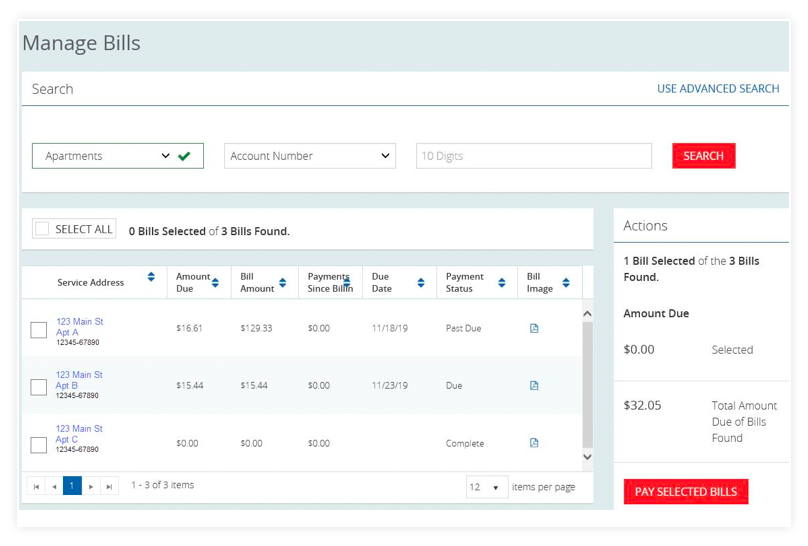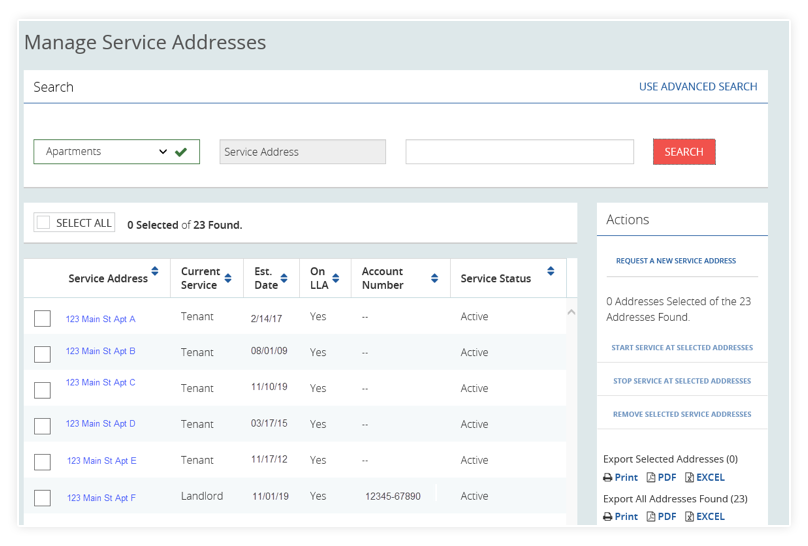Property Managers
Managing a property is no easy task. That’s why we’re happy to offer you an online portal to make your job a little simpler. With our portal, you can view and manage all of your accounts and service addresses in one place.
Already have a login? Sign in here.

Manage Bills
See account balances and select multiple accounts at one time.

Manage Service Addresses
Verify the tenant’s connect date, request to start and stop services in the landlord’s name and remove selected properties as needed.

View Reports
Monitor usage and dig into the details of your monthly bills.
How to Sign Up
To access our Property Managers Portal, you will need to follow these easy steps:
- Go to our sign up page: Portal Sign Up.
- If you have a profile, select Proceed and login. If you do not have a profile, select Register to create a profile.
- On the Setup Your Portal page, click Proceed (in red) in the box for Primary User.
Note: If you want to set up a Landlord Agreement, click on Landlord Agreements under Resources (in the gray area at the bottom of the page). - Fill out the New Property Information form (include a list of rental addresses on the form).
- A confirmation page will appear to verify your request has been submitted.
- You will receive an email confirmation when your properties are ready to view online.
If you have questions, please feel free contact us through the Southern Company website.

Need assistance with your business needs?
Call our Business Service Center at 1-888-430-5787. We are open Monday through Friday from 8 a.m. until 5 p.m.
Contact UsSave money and energy by following our simple energy efficiency tips.
It doesn’t take much to notice a big difference.
Heating and Cooling
Provide all air handling units with an economizer with enthalpy control. Applications include all areas and buildings that can use outside air for "free cooling" during a significant portion of the year. This reduces the energy required to operate a chilled water plant.
Heating and Cooling
To increase the efficiency of a boiler by 2 to 3 percent, install an economizer. This device preheats the feedwater (returned condensate). In the case of a 250-horsepower boiler, an initial investment of $6,000 provides an annual savings of more than $3,000.
Insulation
Incorporating low-E glazing on glass windows will improve the energy efficiency of your facility year-round. During the cooling season, long-wave infrared radiation from outside the facility is blocked before it can pass through the glass, thus reducing the cooling load.
Heating and Cooling
Insulate exposed hot-water, steam and chilled-water distribution piping and valves where feasible.
Heating and Cooling
Pump and fan capacities can be reduced and energy saved by using variable speed drives to control their speed. These are low-cost alternatives to expensive electric drive modifications. Reductions in both peak and off-peak energy costs can be obtained by using variable speed drives on pumps, fans and compressors that operate at varying loads.
Lighting
Increasing the amount of natural light used in your facilities dramatically lowers your utility bills. The more artificial lighting used, the greater the heat load imposed on the air-conditioning system. This is a critical point because artificial lighting and air conditioning consume the largest amount of electrical energy in a typical commercial building.
Heating and Cooling
The costs of properly maintaining boilers are fully recovered in fuel savings. To ensure peak efficiency, remove scale, replace leaky tubes and flanges, remove damaged insulation and control linkages, and recalibrate controls.
Heating and Cooling
To reduce costs, investigate using the economizer cycle to cool a building at night.
General
Encourage employees to turn off computers, monitors, printers and copiers when they are not being used. Consider equipping computers with devices that turn them off automatically after a set period of inactivity.
Lighting
The goals statement for a comprehensive lighting energy conservation program should read: turn it off when it isn't needed; use the most efficient, suitable equipment; and provide light only where it is needed.
Heating and Cooling
Maintaining cleaner heating and cooling coils by using and regularly changing filters can lead to greater efficiencies. Effective filter replacement schedules will reflect changes of use in the building.
Insulation
Seventy-five percent of a building's total air loss is from small leaks. Seal electrical outlets and gaps between moldings, as well as plumbing and wiring penetrations. Attic checkpoints include hatches, plumbing vents, chimneys and other roof or wall penetrations. Many areas can be sealed with a caulk gun and tubes of silicone or urethane caulking.
Heating and Cooling
To conserve energy, make inexpensive repairs and improvements to the HVAC mechanical system as required. For heating efficiency, repair or replace burners and add radiator reflectors. Install flue dampers or balance the ventilation system to reduce the exhaust rate. Relocate thermostats, install fans to keep hot air off the ceiling, and install thermostats in hot water tanks.
Lighting
Fixtures that have state-of-the-art lamps or ballasts (T8 lamps, electronic ballasts, etc.) may save plenty of energy but may also require a higher premium at relamping or reballasting time. Much of this cost is offset because of the longer life. This longer life not only cuts down on replacement component costs but also reduces the associated labor expense to replace them.
General
Perform regular energy audits to establish the basic costs and uses of energy forms including electricity, gas and steam, and to identify waste or inefficiency. By identifying on-peak and off-peak periods, you can take advantage of a utility's rate structure.
Lighting
Incorporate motion detectors to reduce lighting usage and save energy.
Heating and Cooling
Consider installing instruments to monitor real-time, cooling plant efficiency in kw/ton. The saying goes, what gets measured, gets done. If efficiency is your goal, then you need an indicator of how well you are doing.
Insulation
Select replacement windows with a 0.46 U-value or better with optical properties that are appropriate for building use. (U-0.46 is a low-E window in a thermally improved metal frame.)
Heating and Cooling
Rejected waste heat from air conditioning or refrigeration equipment can often be used to serve building needs. The potential energy savings and cost benefits depend on how many hours per year of excess energy are available and also on whether that heat can be used for purposes that would otherwise require purchased energy.
Lighting
When retrofitting an existing lighting system, high overall light levels can be reduced when good task lighting is installed. A combination of good, sensible lighting design with the use of the latest technology can result in substantial energy savings and an overall improvement in lighting quality.
Lighting
In many cases, high overall light levels can be reduced when good task lighting is installed. A combination of good, sensible lighting design with the use of the latest technology lighting systems can result in substantial energy savings and an overall improvement in lighting quality.
Heating and Cooling
To improve cooling tower efficiency, lower the cooling tower fan horsepower by adding surface area and free area within the tower fill. These additions result in a five to 10 times lower load on the cooling tower fans. The motors can therefore be resized. The tower performance goal should be .012 kw/ton or better.
General
Dehumidification equipment helps prevent illnesses and lost productivity.
Insulation
Light energy can be controlled using overhangs to shade windows, shading glass surfaces, and using glazing material for exposed window surfaces. Other methods for controlling heat flow include selecting the correct materials for the walls and roof and using natural ventilation and landscaping. Our experts can help you select strategies, which provide enough savings to justify their expense.
Insulation
Internal walls influence window design and placement. Highly reflective, but not glossy, light-colored walls will spread daylight back from sidewalls. Jewel-toned walls will absorb more light and may require more supplemental lighting sources.
Heating and Cooling
The energy recovered can be redistributed to space conditioning and domestic water heating. Costs are typically low for installing, operating and maintaining these systems. And they are adaptable to future energy sources, such as solar heating. What's more, individual unit control means greater flexibility and comfort.
Heating and Cooling
Consider controlling all the cooling tower fans with one variable frequency drive and modulate the fan speed together.
Lighting
Many lighting control projects have payback periods of less than one year. Daylighting control systems examine the total amount of light available in a given space and switch off one or more banks of lights whenever enough sunlight is available. Daylighting control systems are particularly well suited for use in facilities with large areas of exterior glass.
Heating and Cooling
Although individual components of the HVAC system, such as the chiller, may be quite efficient, the overall system may contain inefficiencies that need to be fixed.
Lighting
LEDs get progressively dimmer over time, which is helpful in critical lighting areas.
Insulation
In addition to their aesthetic values, interior window treatments can reduce energy consumption. Insulating vertical or horizontal blinds and/or draperies can reduce heat loss and solar gain through window openings.
General
To conserve energy, allow elevators to time out and shut down slowly. They should idle long enough so that the power consumption is equal to or just less than power consumed in starting the motor/generator.
Heating and Cooling
At present, many air conditioning systems are being replaced due to the phaseout of ozone-depleting refrigerants. This is an excellent opportunity to incorporate design features that reduce the cooling load on the system. Updating the system results in lower equipment and energy costs.
Heating and Cooling
Structures such as hospitals, universities and industrial facilities use high- and medium-pressure steam containing valuable energy that can be recovered. Avoid venting this steam into the atmosphere where its heat is wasted. Instead, use the recovered heat to preheat domestic hot water or returned hot water from the building's heating system.
Lighting
The initial cost of a state-of-the-art system may even be lower than the overall cost of a less expensive and less efficient system if you use fewer fixtures to achieve the same or better light levels, and if you can tap into utility rebates and other incentives.
Heating and Cooling
For peak efficiency, repair or replace damaged or missing boiler insulation.
Heating and Cooling
Think system efficiency when making decisions about conservation strategies. For instance, you may have the most efficient chiller available, but if parasitic loads from chilled water and cooling tower pumps are high, then the system efficiencies could be quite low.
Heating and Cooling
To avoid losing efficiency, calibrate pneumatic thermostats every three to six months. The exact frequency depends on the condition of the air supply and how often occupants tamper with thermostats.
Heating and Cooling
The right system can be retrofitted to greatly reduce energy costs.
Insulation
Window films not only reduce air conditioning loads but also help reduce heating energy use. In optimum situations, energy savings frequently pay back the cost of film installation in a year or less. In a surprisingly large number of cases, building owners have been able to pay back the cost of window film installation directly from energy savings.
Heating and Cooling
96% of electric infrared heat generated goes to the person or object.
Lighting
Replace your 10- or 20-watt incandescent lamps in exit signs with LEDs. While the incremental energy savings may seem small, the continual operation of exit signs makes the retrofit very cost effective.
General
Operating chillers at peak performance will save energy and maintenance.
Insulation
Uninsulated brick walls are very common, particularly in buildings constructed prior to 1960. You can realize significant energy savings by adding insulation using one of three methods: furring the interior surface, insulating the cavity or insulating the exterior.
Heating and Cooling
Shutting down unnecessary auxiliary HVAC equipment improves system efficiency without impacting performance. To save energy in central HVAC plants, turn off auxiliary equipment such as cooling tower fans and circulating pumps for chilled water and condenser water when not required.
Lighting
Full-range dimming systems can significantly reduce the power delivered to fluorescent lights and can even be activated in response to available daylight for perimeter areas.
Heating and Cooling
When specifying piping insulation, look at both the maximum temperature it will be exposed to and the minimum temperature.
Heating and Cooling
Infrared heaters boost temps first, so you boost productivity.
General
Artificial lighting and air conditioning consume the largest amount of electrical energy in a typical commercial building. The more artificial lighting is used, the greater the heat load imposed on the air conditioning system from lamps and ballasts. Carefully increasing the amount of natural light will decrease the need for artificial light, reducing energy in both lighting and air conditioning systems.
Insulation
To improve the thermal-insulating characteristics of aluminum frame windows, request that the window must include a thermal break, which is an insulating section placed between the inner and outer aluminum sections of the frames.
Heating and Cooling
Use cooling towers to save energy in cooling plants by delivering cooler water to the chillers.
Lighting
LED lighting uses 2-3 times less energy than most CFLs.
Heating and Cooling
To improve chiller performance, monitor outside air temperature and humidity to control chilled water supply temperature. Even in hot, humid climates, you can increase the chilled water supply temperature and still maintain building comfort year-round.
Heating and Cooling
Using a thermal storage system in the chiller plant conserves energy, particularly when there is a significant difference in energy demand between peak and off-peak hours.
Lighting
Get rid of mercury lamps inside and outside a building. Their light output reduces over time, and a dim mercury lamp uses as much energy as a brand new one. Replace them with high-pressure sodium or metal halide lamps.
General
Heat recovery systems can reduce ventilation costs by 50% or more.
Heating and Cooling
Consider a thermal storage system when designing your chiller plant. With a thermal storage system, the idea is to run chiller equipment during off-peak periods and store cooled water or ice, then draw on this cooling during the peak times of the day.
Water Heating
Gas water heaters lose 3.5% stored heat per hour. Electric units lose 1%.
Heating and Cooling
In multiple tower/chiller installations, run all the water over all the fill when possible.
Cooking
Savings from gas cooking are lost to increased costs of air conditioning.
